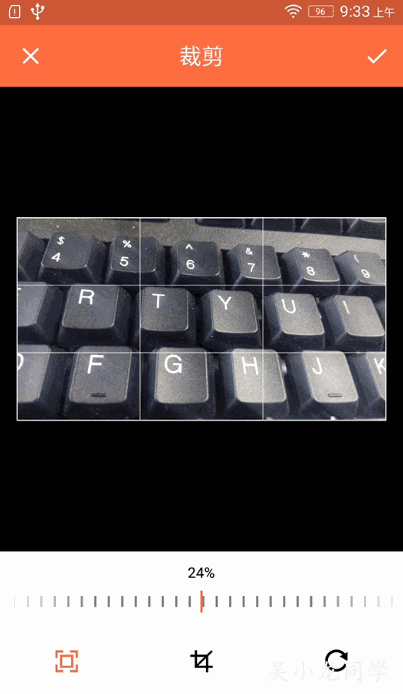uCrop使用及源码浅析
uCrop使用
github地址
https://github.com/Yalantis/uCrop
然后clone或下载到本地,运行之。
效果预览

app/build.gradle
compile 'com.yalantis:ucrop:1.5.0'
AndroidManifest.xml
<activity
android:name="com.yalantis.ucrop.UCropActivity"
android:screenOrientation="portrait"
android:theme="@style/Theme.AppCompat.Light.NoActionBar" />
这里theme可以改成自己的
配置uCrop
/**
* 启动裁剪
* @param activity 上下文
* @param sourceFilePath 需要裁剪图片的绝对路径
* @param requestCode 比如:UCrop.REQUEST_CROP
* @param aspectRatioX 裁剪图片宽高比
* @param aspectRatioY 裁剪图片宽高比
* @return
*/
public static String startUCrop(Activity activity, String sourceFilePath,
int requestCode, float aspectRatioX, float aspectRatioY) {
Uri sourceUri = Uri.fromFile(new File(sourceFilePath));
File outDir = Environment.getExternalStoragePublicDirectory(Environment.DIRECTORY_PICTURES);
if (!outDir.exists()) {
outDir.mkdirs();
}
File outFile = new File(outDir, System.currentTimeMillis() + ".jpg");
//裁剪后图片的绝对路径
String cameraScalePath = outFile.getAbsolutePath();
Uri destinationUri = Uri.fromFile(outFile);
//初始化,第一个参数:需要裁剪的图片;第二个参数:裁剪后图片
UCrop uCrop = UCrop.of(sourceUri, destinationUri);
//初始化UCrop配置
UCrop.Options options = new UCrop.Options();
//设置裁剪图片可操作的手势
options.setAllowedGestures(UCropActivity.SCALE, UCropActivity.ROTATE, UCropActivity.ALL);
//是否隐藏底部容器,默认显示
options.setHideBottomControls(true);
//设置toolbar颜色
options.setToolbarColor(ActivityCompat.getColor(activity, R.color.colorPrimary));
//设置状态栏颜色
options.setStatusBarColor(ActivityCompat.getColor(activity, R.color.colorPrimary));
//是否能调整裁剪框
options.setFreeStyleCropEnabled(true);
//UCrop配置
uCrop.withOptions(options);
//设置裁剪图片的宽高比,比如16:9
uCrop.withAspectRatio(aspectRatioX, aspectRatioY);
//uCrop.useSourceImageAspectRatio();
//跳转裁剪页面
uCrop.start(activity, requestCode);
return cameraScalePath;
}
其他配置
//设置Toolbar标题
void setToolbarTitle(@Nullable String text)
//设置裁剪的图片格式
void setCompressionFormat(@NonNull Bitmap.CompressFormat format)
//设置裁剪的图片质量,取值0-100
void setCompressionQuality(@IntRange(from = 0) int compressQuality)
//设置最多缩放的比例尺
void setMaxScaleMultiplier(@FloatRange(from = 1.0, fromInclusive = false) float maxScaleMultiplier)
//动画时间
void setImageToCropBoundsAnimDuration(@IntRange(from = 100) int durationMillis)
//设置图片压缩最大值
void setMaxBitmapSize(@IntRange(from = 100) int maxBitmapSize)
//是否显示椭圆裁剪框阴影
void setOvalDimmedLayer(boolean isOval)
//设置椭圆裁剪框阴影颜色
void setDimmedLayerColor(@ColorInt int color)
//是否显示裁剪框
void setShowCropFrame(boolean show)
//设置裁剪框边的宽度
void setCropFrameStrokeWidth(@IntRange(from = 0) int width)
//是否显示裁剪框网格
void setShowCropGrid(boolean show)
//设置裁剪框网格颜色
void setCropGridColor(@ColorInt int color)
//设置裁剪框网格宽
void setCropGridStrokeWidth(@IntRange(from = 0) int width)
onActivityResult
经过裁剪,返回结果,这里我一般只需要裁剪后的图片绝对路径(调用上面startUCrop,即返回图片路径),然后调接口上传服务器。
@Override
public void onActivityResult(int requestCode, int resultCode, Intent data) {
if (resultCode == RESULT_OK && requestCode == UCrop.REQUEST_CROP) {
final Uri resultUri = UCrop.getOutput(data);
} else if (resultCode == UCrop.RESULT_ERROR) {
final Throwable cropError = UCrop.getError(data);
}
}
uCrop源码浅析
uCrop源码能学习的东西有很多,比如左右滑的标尺,不过我们这里源码浅析只关注裁剪部分。
类关系
首先有个大概了解:

GestureCropImageView:负责监听各种手势
CropImageView:主要完成图片裁剪工作,和判断裁剪图片是否充满裁剪框
TransformImageView:负责图片旋转、缩放、位移操作
入口
由上面的效果图可知,点击右上角,调用裁剪操作,代码如下:
@Override
public boolean onOptionsItemSelected(MenuItem item) {
if (item.getItemId() == R.id.menu_crop) {
cropAndSaveImage();
}
return super.onOptionsItemSelected(item);
}
//裁剪和保存图片
protected void cropAndSaveImage() {
……
mGestureCropImageView.cropAndSaveImage(mCompressFormat, mCompressQuality, new BitmapCropCallback() {
@Override
public void onBitmapCropped(@NonNull Uri resultUri) {
setResultUri(resultUri, mGestureCropImageView.getTargetAspectRatio());
finish();
}
@Override
public void onCropFailure(@NonNull Throwable t) {
setResultError(t);
finish();
}
});
}
这里调用了GestureCropImageView&cropAndSaveImage方法,如下:
/**
* @param compressFormat 图片压缩格式
* @param compressQuality 图片压缩质量
* @param cropCallback 图片压缩回调
*/
public void cropAndSaveImage(@NonNull Bitmap.CompressFormat compressFormat, int compressQuality,@Nullable BitmapCropCallback cropCallback) {
//取消所有动画
cancelAllAnimations();
//判断裁剪图片是否充满裁剪框
setImageToWrapCropBounds(false);
//进行裁剪
new BitmapCropTask(getViewBitmap(), mCropRect, RectUtils.trapToRect(mCurrentImageCorners),
getCurrentScale(), getCurrentAngle(),
mMaxResultImageSizeX, mMaxResultImageSizeY,
compressFormat, compressQuality,
getImageInputPath(), getImageOutputPath(),
cropCallback).execute();
}
裁剪之前
setImageToWrapCropBounds
裁剪之前,先判断裁剪图片是否充满裁剪框,如果没有,进行移动和缩放让其充满。
public void setImageToWrapCropBounds(boolean animate) {
//mBitmapLaidOut图片加载OK,isImageWrapCropBounds()检查图片是否充满裁剪框
if (mBitmapLaidOut && !isImageWrapCropBounds()) {
//当前图片中心X点
float currentX = mCurrentImageCenter[0];
//当前图片中心Y点
float currentY = mCurrentImageCenter[1];
//当前图片缩放值
float currentScale = getCurrentScale();
//差量
float deltaX = mCropRect.centerX() - currentX;
float deltaY = mCropRect.centerY() - currentY;
float deltaScale = 0;
//临时矩阵重置
mTempMatrix.reset();
//临时矩阵移动
mTempMatrix.setTranslate(deltaX, deltaY);
//复制到新的数组
final float[] tempCurrentImageCorners = Arrays.copyOf(mCurrentImageCorners, mCurrentImageCorners.length);
//将此矩阵应用于二维点的数组,并编写转换后的指向数组的点
mTempMatrix.mapPoints(tempCurrentImageCorners);
//再检查图片是否充满裁剪框
boolean willImageWrapCropBoundsAfterTranslate = isImageWrapCropBounds(tempCurrentImageCorners);
if (willImageWrapCropBoundsAfterTranslate) {
//图片缩进的数组
final float[] imageIndents = calculateImageIndents();
deltaX = -(imageIndents[0] + imageIndents[2]);
deltaY = -(imageIndents[1] + imageIndents[3]);
} else {
RectF tempCropRect = new RectF(mCropRect);
mTempMatrix.reset();
mTempMatrix.setRotate(getCurrentAngle());
mTempMatrix.mapRect(tempCropRect);
//获取裁剪图片的边
final float[] currentImageSides = RectUtils.getRectSidesFromCorners(mCurrentImageCorners);
deltaScale = Math.max(tempCropRect.width() / currentImageSides[0],
tempCropRect.height() / currentImageSides[1]);
deltaScale = deltaScale * currentScale - currentScale;
}
if (animate) {
//移动或缩放图片(有动画效果)
post(mWrapCropBoundsRunnable = new WrapCropBoundsRunnable(
CropImageView.this, mImageToWrapCropBoundsAnimDuration, currentX, currentY, deltaX, deltaY,
currentScale, deltaScale, willImageWrapCropBoundsAfterTranslate));
} else {
//移动图片
postTranslate(deltaX, deltaY);
if (!willImageWrapCropBoundsAfterTranslate) {
//缩放图片
zoomInImage(currentScale + deltaScale, mCropRect.centerX(), mCropRect.centerY());
}
}
}
}
进行裁剪
裁剪放到了异步,即BitmapCropTask继承AsyncTask,先设置原始图片resizeScale值,然后通过ExifInterface保存新的图片,即裁剪后的图片。
public class BitmapCropTask extends AsyncTask<Void, Void, Throwable> {
……
/**
* @param viewBitmap 裁剪图片bitmap
* @param cropRect 裁剪矩形
* @param currentImageRect 当前图片矩形
* @param currentScale 当前图片缩放值
* @param currentAngle 当前图片角度
* @param maxResultImageSizeX 图片裁剪后最大宽值
* @param maxResultImageSizeY 图片裁剪后最大高值
* @param compressFormat 图片裁剪的格式
* @param compressQuality 图片裁剪的质量
* @param imageInputPath 裁剪图片路径
* @param imageOutputPath 图片裁剪后路径
* @param cropCallback 裁剪回调
*/
public BitmapCropTask(@Nullable Bitmap viewBitmap,
@NonNull RectF cropRect, @NonNull RectF currentImageRect,
float currentScale, float currentAngle,
int maxResultImageSizeX, int maxResultImageSizeY,
@NonNull Bitmap.CompressFormat compressFormat, int compressQuality,
@NonNull String imageInputPath, @NonNull String imageOutputPath,
@Nullable BitmapCropCallback cropCallback) {
……
}
@Override
@Nullable
protected Throwable doInBackground(Void... params) {
if (mViewBitmap == null || mViewBitmap.isRecycled()) {
return new NullPointerException("ViewBitmap is null or already recycled");
}
if (mCurrentImageRect.isEmpty()) {
return new NullPointerException("CurrentImageRect is empty");
}
//设置resizeScale值
float resizeScale = resize();
try {
//裁剪
crop(resizeScale);
//回收
mViewBitmap.recycle();
mViewBitmap = null;
} catch (Throwable throwable) {
return throwable;
}
return null;
}
private float resize() {
//初始Options
final BitmapFactory.Options options = new BitmapFactory.Options();
//查询该位图,而无需分配存储器,可获取outHeight(图片原始高度)和 outWidth(图片的原始宽度)
options.inJustDecodeBounds = true;
//裁剪图片解码
BitmapFactory.decodeFile(mImageInputPath, options);
//原始图片和裁剪后图片比值
float scaleX = options.outWidth / mViewBitmap.getWidth();
float scaleY = options.outHeight / mViewBitmap.getHeight();
float resizeScale = Math.min(scaleX, scaleY);
mCurrentScale /= resizeScale;
//初始化值为1
resizeScale = 1;
if (mMaxResultImageSizeX > 0 && mMaxResultImageSizeY > 0) {
float cropWidth = mCropRect.width() / mCurrentScale;
float cropHeight = mCropRect.height() / mCurrentScale;
if (cropWidth > mMaxResultImageSizeX || cropHeight > mMaxResultImageSizeY) {
scaleX = mMaxResultImageSizeX / cropWidth;
scaleY = mMaxResultImageSizeY / cropHeight;
//设置resizeScale,如果是2就是高度和宽度都是原始的一半
resizeScale = Math.min(scaleX, scaleY);
mCurrentScale /= resizeScale;
}
}
return resizeScale;
}
private boolean crop(float resizeScale) throws IOException {
//ExifInterface这个接口提供了图片文件的旋转,gps,时间等信息,从原始图片读出Exif标签
ExifInterface originalExif = new ExifInterface(mImageInputPath);
int top = Math.round((mCropRect.top - mCurrentImageRect.top) / mCurrentScale);
int left = Math.round((mCropRect.left - mCurrentImageRect.left) / mCurrentScale);
int width = Math.round(mCropRect.width() / mCurrentScale);
int height = Math.round(mCropRect.height() / mCurrentScale);
//复制图片
boolean cropped = cropCImg(mImageInputPath, mImageOutputPath,
left, top, width, height, mCurrentAngle, resizeScale,
mCompressFormat.ordinal(), mCompressQuality);
if (cropped) {
//拿到裁剪后图片
copyExif(originalExif, width, height);
}
return cropped;
}
@SuppressWarnings("JniMissingFunction")
native public boolean cropCImg(String inputPath, String outputPath,
int left, int top, int width, int height, float angle, float resizeScale,
int format, int quality) throws IOException, OutOfMemoryError;
/**
* @param originalExif 原始图片Exif
* @param width 裁剪后图片宽
* @param height 裁剪后图片高
* @throws IOException 是否异常
*/
public void copyExif(ExifInterface originalExif, int width, int height) throws IOException {
//Exif标签数组
String[] attributes = new String[]{
ExifInterface.TAG_APERTURE,
……
};
//指定裁剪后图片路径,初始化新的ExifInterface
ExifInterface newExif = new ExifInterface(mImageOutputPath);
String value;
for (String attribute : attributes) {
value = originalExif.getAttribute(attribute);
if (!TextUtils.isEmpty(value)) {
//设置Exif标签
newExif.setAttribute(attribute, value);
}
}
newExif.setAttribute(ExifInterface.TAG_IMAGE_WIDTH, String.valueOf(width));
newExif.setAttribute(ExifInterface.TAG_IMAGE_LENGTH, String.valueOf(height));
newExif.setAttribute(ExifInterface.TAG_ORIENTATION, "0");
//保存
newExif.saveAttributes();
}
@Override
protected void onPostExecute(@Nullable Throwable t) {
if (mCropCallback != null) {
if (t == null) {
//接口回调,over
mCropCallback.onBitmapCropped(Uri.fromFile(new File(mImageOutputPath)));
} else {
mCropCallback.onCropFailure(t);
}
}
}
}
AndroidProgrammer
我的微信公众号:Android高手进阶之路,让我们共同学习,每天进步一点点。欢迎微信扫一扫关注。

总结
uCrop功能强大,对于我来说,有很多东西值得学习,难点如Rect包含问题(其实这块还不是很理解),新知识如ExifInterface操作图片,BitmapFactory显示图片的知识点温故等,还有自定义左右滑的标尺,都是不错的学习源码。
正文到此结束
热门推荐
相关文章
Loading...











![[HBLOG]公众号](https://www.liuhaihua.cn/img/qrcode_gzh.jpg)

